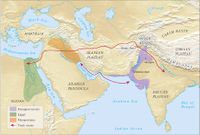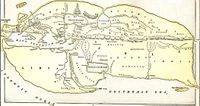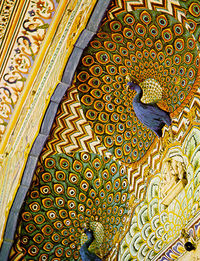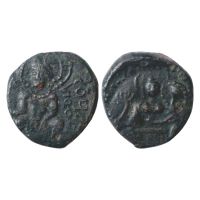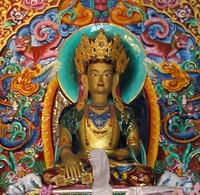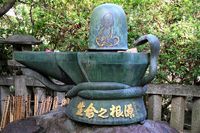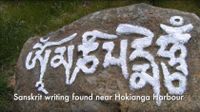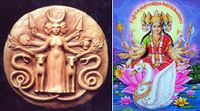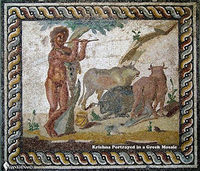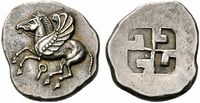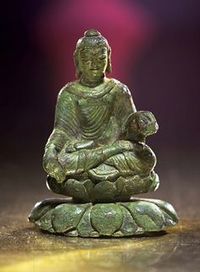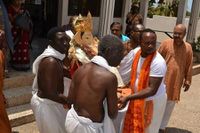The Spread of Hinduism

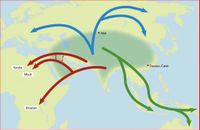
“Hinduism the perennial philosophy that is at the core of all religions.” - Aldous Huxley
Hindu teachings were spread not just by Indian Hindus migrating and preaching outside of the Indian Subcontinent, but also by visitors to India who came for understanding Hindu spirituality. This latter section includes Greek philosophers such as Pythagoras, Orpheus and Plato, who had all returned to Greece and preached the concepts of karma, bhakti, gyāna, reincarnation and Mokṣa. Iranian philosophers such as Mani also visited India and later preached similar messages as the Greeks who had become Hindu.
Hindu scholars noted for their wisdom had further promoted the religion through becoming advisers to monarchs outside of India. Kingdoms Kucha[1] and Tukhara[2] in Central Asia, Mongolia[3], Naiman[4] in Western Mongolia, Tibet[5] and mainland China[6], all chose Indian Hindu advisers who promoted Hinduism throughout their kingdoms. Soon an era came in which Greek philosophers describe that 'Greater India' came into being with cultural similarities between many regions outside India. Central Asia was known as Serindia, while from Burma to the Strait of Malacca became Indochina and the islands of the Strait of Malacca became Indonesia.
Around 4000-3000 BCE, is when exploration in the Indian Ocean had began, and the international regions to communicate with one another were India, Gulf (i.e., Mesopotamia), and Oman.[7] The curiosity of places outside of India and knowledge of trading routes had led to the Indian diaspora both from sea and land. Following this the Yamnaya culture of Europe that prospered from 3500-2500 BCE, which consisted of mixed peoples from both Indo-Iranian and native European ancestry was established around 3500-3200 BCE. Hindu scholars, including scientists and missionaries, remained explorers and documented the various geographies of global places wherein they traveled.
Of the Indian Hindus in the ancient times that established colonies abroad, noteworthy are the Danavas of Sind province that, with their navigation expertise, had settled in various places where they had come to be been known as Danuna, Danunites, Danaoi, Danaus, Danaids, Dene, Danai, Danaian, and Dananns. Historians have noted tribes with the demonym 'Sindi' among the Thracians, Colchis, and both ancient and modern Kurds.
With the spread of British colonialism in the modern era, many Indians started regularly traveling and emigrating to other British colonies outside of India. Many others also traveled to other colonies, such as of France and Netherlands. Resulting from this diffusion and establishment of communities abroad, Indian Hindus have gone on to democratically achieve becoming leaders of countries such as Guyana, Suriname, Fiji and Mauritius. From colonialism, Europeans also received the opportunities to travel to India and then share spiritual ideas with Western nations. As such, the establishment of the Theosophical Society by Helena Blavatsky and Agni Yoga by Nicholas Roerich. The modern age has given a boost to Hinduism through organizations such as the Hare Krishnas, Ananda Margis, Brahma Kumaris and others. Yoga has spread now and is practiced by many non-Hindus for improving and maintaining both physical and mental health.
“South Asia, which is where Bos Indicus (zebu cattle) originated, was not isolated during this period. People seem to have migrated from the Indus Valley civilization into Central Asia around the same time as the climatic effect that happened around 4,200 years ago. This may have introduced zebu cattle ancestry into Near Eastern cattle populations.” - Iosif Lazaridis, Harvard Medical School geneticist[8]
The influence of Hindus and Moksh-based religions to the history of the world is definitely undeniable. Mahatma Gandhi changed the world forever and his message of peaceful non-cooperation to obtain freedom and justice was implemented by other freedom fighters in former colonies, and by notable figures towards national reform as in the cases of Martin Luther King Junior and Aung San Suu Kyi. Time Magazine ranked him as number 54 on the list the most significant figures in all of history[1], on the list of the important 20th century persons while WondersList[2] as number 5 for that list, Time as number 9 for one of history’s most important leaders[3], BBC as one of the most important philosophers, and other sources like Historyplex[4] as one of the most important persons overall in all of history.
Middle East[edit]
"Slowly and gradually, it dawned upon them that the language of the Gatha and Zendavesta has very great kinship with the Sanskrta language; when the grammar of Panini, Katyayana, and Patanjali was applied then the Gatha and Zendavesta came to be understood by the westerners. The lesson from this amazing fact is clear that once the Iranians of the Gatha and Zendavesta and the Indo-Aryans of the Vedas formed one single race, speaking language akin to Samskrta. Indeed this is clear from the city tablets found in Tell-El-Amarna in Egypt and Boghaz Keui in Asia Minor. On the tablets are mentioned Indra, Varuna, Mitra and Nasatya as witnesses of the treaty between the King Subiluliuma of the Hittites, and the Mitanni King Mattiwaza. These tablets date to about 1600 B.C. These tablets clearly indicate that these Vedic gods who were quite familiar in the region about 1600 B.C. and that the people living there then had more or less a common religion."
- Yaqub Masih[9]
The process of Hinduism spreading in the Middle East is whereby Hindus left India and had traveled to regions within the ancient Neat East and had preached the doctrine and customs. Hindus of Mitanni were Hurrians while those of Anatolia were Hittites, those of Levant the Hurus and those of Egypt, the Hyksos.
| Ketumalavarsha indeed extends from Romakapura to [the] Gandhamadana [mountain]. | ||
—Srimad Bhagavatam | ||
Iranian Plateau[edit]
See also: Zoroastrianism and Hinduism



- Movement of Indians into Iran
"Slowly and gradually, it dawned upon them that the language of the Gatha and Zendavesta has very great kinship with the Sanskrta language; when the grammar of Panini, Katyayana, and Patanjali was applied then the Gatha and Zendavesta came to be understood by the westerners. The lesson from this amazing fact is clear that once the Iranians of the Gatha and Zendavesta and the Indo-Aryans of the Vedas formed one single race, speaking language akin to Samskrta." - Yaqub Masih[12]
Ancient Iranian lands had a diversity of spiritual beliefs and the religions included Zoroastrianism, Manicheism, Yazdanism, Mandeanism and others. As the original Indo-Iranian homeland was eastwards in the Himalayas, the nations of those areas spread westwards and found existing non-Indo-European peoples there such as Kasodians in Gilan, Taporians in Mazandaran, Urartians in the Caucus Mountain Range, Turukkus, Kassites and Lolobites in the Zagros Mountain Range and Elamites on the southern shoreline. The Turkic groups were known collectively to the natives as the 'Turani'[13] and they were associated with Dānu, just as the Tarukṣas coming into India were too. The non-Indo-Iranians (or non-Aryans) were known to the Aryans as 'Anariakoi' (non-Aryan people), and this was the term documented by Greek writers for Hyrcanians[14] and others. Overtime, the Indo-Iranian cultural significance in the societies of the plateau led to the formation of Indo-Iranian nations that were native to the region (i.e., Hurrians, Baluchis, Armenians.) A Turani monarch had however opposed the Indo-Iranian influence on the plateau and invaded Balkh.[15] After its conquest both its king and the king's close friend Zarathustra were executed by invading Turanis.[16]
Sir William Jones notes:
Thus it has been proved by clear evidence and plain reasoning that a powerful monarch was established in Iran long before the Assyrian or Pishadi government. That it was in fact, a Hindu monarchy, though any may choose to call it Cusian, Casdean or Scythian..."[17]
- Closeness between religions of Iran to Hinduism
Zoroastrianism, which is also known as Mazdayasna (Sacrifice to Ahura Mazda) and as Vehdin (Good Religion), resembles Hinduism in many ways, such as in its origin, beliefs (i.e., common deities) and iconography. Dr. Mills says, "The Avesta is nearer the Veda than the Veda to its own epic Sanskrit." Major gods or yazatas[18] included Varuṇa and Mitra. Zarathustra (Greek: Zoroaster) Spitama was an Athravan priest, a descendant of the Vedic Atharvans. The swastika has been a popular symbol throughout the history of Iran and it has been called by Persians, "The four horses of Mitra."
Among the followers of Zoroastrianism, while the scriptures do not mention the idea of re-incarnation, it is not denied either[19] and some Zoroastrians of India[20] believe in reincarnation.[21] Some esoteric Parsi mystics such as Beaman adhered to the belief in reincarnation.[22] The belief in karma and re-incarnation are perpetuated in the Desatir, wherein it declares that those who are happy now have done good deeds in a previous life while those who suffer now have done bad deeds in former life.[23] It is therefore discredited as a Mazdaean work.
Of Mandeans, Chevalier Emerys writes, "Modern Johannite Mandean Christians of Iraq, also known as Nazoreans, still believe in the doctrine of reincarnation and also teach that Jesus was the reincarnation of the prophet Melchizedek."[24] The Mandeans also believe in reincarnation of the human, if a human does not marry within his or her lifetime.[25] Islamic Druzism believes in reincarnation, and is named after Persian Batinite missionary named Muhammad bin Ismail Nashtakin ad-Darazi. Muslim Shah Ismail the Persian Sultan was one of the founders of Alevism or the "People of Fire" and this Islamic sect believes in reincarnation. The Islamic sects of Shabak, Bajalan, Sarli, and Kakais are also very closely affiliated with Iranians and has a belief in re-incarnation.
After the Islamization of the Iranian Plateau, some intellectuals resisted and established their own new religions, which contained some hindu ideas and some other themes that they were familiar with. This includes, Yarsanism (Ahl-e Haqq) established in the 14th century by Sultan Sahak as a Yazdan sect and Baha'ism by Bahá'u'lláh in the 19th century. Whereas both traditional Hinduism and Buddhism were popular in the eastern part of the Iranian Plateau, Mithraism became popular within Zoroastrianism particularly in the western part. From here the popularity of the god Mitra spread to Assyria, Anatola and Europe. The Avesta declares, "This Mitra, the lord of the wide pastures, I have created as worthy of sacrifice, as I, Ahura Mazda, am myself."[26] Philosopher Mani of Persia had spent time in India, and after having accepted the ideas of re-incarnation and the three paths to Mokṣa, he began preaching of them in Iran. His set of beliefs are called Manicheism.
- Association of regions within Iranian Plateau to India
The Zoroastrian Vendidad reads, "The country of Hind extends from east of the Indus to west of it." This, India in the Vendidad's definition includes Baluchistan and Seistan.
Ancient Persians called the regions stretching from Hormuz to Baluchistan as 'Hind'[27] because those areas had more in common with India than with the other Iranian cultures located west to them. King Dhrishataketu of Kaikeya Kingdom married Śrutakirtti and had by her Santarddana, and four other sons, known together as the five Kaikeyas. The Kaikeyas were a major dynasty in India and it was on both sides of the Indus River. The Anava Kingdom of Uśinara Sibi, extended from Baluchistan to the Punjab. Even modern times Sibi is a district within Baluchistan.
Further, the Helmand region of Afghanistan was called by Persians as 'White India'. Siestan was also referred by Greek philosophers to as White India. Referring to the peoples of this region, Alexander called them, "the Indians on this side of the river Indus."[28]
Overtime, the natives of this region stayed and many became Buddhist in modern-day Afghanistan and the Afghans turned Kandahar into a Buddhist pilgrimage center which was visited by devout Buddhists from China and Indonesia. While Takśaśila was a city in east of the Indian river on the Iranian side, there were other important centres. The two great Indian grammarians Panini and Patanjali have mentioned a number of north-western cities like Balkh or Vahika, Kapisa, Pushkalavati, Masakavati, Takśaśila and Sakala. Takśaśila was the greatest and most flourishing city.[29]
- Modern Relations between the Plateau and Hinduism
Hare Krishna's founder A.C. Bhaktivedanta Swami Prabhupada traveled to Tehran in 1976. Since 1977, ISKCON runs a vegetarian restaurant in Tehran.
Assyria[edit]
Assyria was known as Asuristan.[30] The name of Assyria comes from Rigvedic 'Asurya', the original name of the sun-god Surya. Syrians still to this day, pronounce the name of Syria as 'Surya'. Hence, Assyria's name would have been pronounced as 'Asurya'.
In the 6th century CE, the Lower Euphrates was known as 'India within land' or just 'Hind' (India) in general.[31] Oderic in 1320 CE also speaks of the Lower Euphrates as 'India within land'. Much like how the Indus River Civilization had priest-kings as ruler of certain towns and cities, Assyria too had a priest-prince ruler. Hence, from the Indian Hindu influence, Parshurama is also believed to have been worshiped in the region. In the ancient Sumerian social structure as well, there was a leader of the Baramas (i.e., Brahmanas) named Bur-Sin and the belief by some scholars is that he is Parshurama.
The patriarchal god of the Assyrians was Assur, who is always portrayed on a winged chakkra-sun or sundisk, just as the frahavars[32] of Iranian spirituality are shown. The Assyrians, referred to a chakkra as a wheel. The cultural and political capital of the Assyrians was Assur, named after the god. Assur was also known as Asara Mazas[33][34] Furthermore, god Enki was also known as Masda and Masenda. God Assur had later been identified within Judeo-Christian Biblical mythology as Ashur, the son of Shem.
It is believed that Europe had borrowed the planetary names for the week's days that the Babylonians used. Babylon was a part of the Assyrian Empire. When Hindus had spread to Assyria, they had brought this system of the week with them.
| Sunday | Monday | Tuesday | Wednesday | Thursday | Friday | Saturday | |
| Planet | Sun | Moon | Mars | Mercury | Jupiter | Venus | Saturn |
| Hindu deity | Ravi | Soma | Mangala | Buddha | Guru | Shukra | Shani |
| Mazdaen deity[35][36] | Mitra | Vrarayna | Tiriya | Ahura Mazda | Ardvi Anahita Sura | Kayvanu | |
| Assyrian deity[37] | Nergal | Nabu | Marduk | Ishtar | Kajamanu | ||
| Greco-Roman deity | Helios-Sol | Selene-Luna | Ares-Mars | Hermes-Mercury | Zeus-Jupiter | Aphrodite-Venus | Cronus-Saturn |
The Assyrians had referred to India as Melluhha. This comes from the name Mallhu and Malla, which many kings in India, particularly western India and Baluchistan have been called. There was even Mount Malleus mountain that Sind[38] was known for having. Even the coast of Kerala is known as Malankara.
Mitanni[edit]
Today this region is known as Kurdistan. In the ancient times, the inhabitants of Mitanni were known as Hurrians. In the Judeo-Christian Bible, they are known as the Horites.[39] Sanskritic interpretations of Mitanni names render the following:
- Artashumara (artaššumara) - It means that it is as Arta-smara "who thinks of Arta/Ṛta".[40]
- Biridashva (biridaša, biriiaša) - It means that it is as Prītāśva "whose horse is dear".[41]
- Priyamazda (priiamazda) - It means that it is as Priyamedha "whose wisdom is dear".[42]
- Citrarata as citraratha - It means that it is "whose chariot is shining".[43]
- Indaruda/Endaruta - It means that it is as Indrota "helped by Indra".[44]
- Shativaza (šattiaza) - It means that it is as Sātivāja "winning the race price".[45]
- Šubandhu as Subandhu - It means that it is like 'having good relatives".[46][47]
- Tushratta (tišeratta, tušratta, etc.) - It means that it is as taišaratha, Vedic Tveṣaratha "whose chariot is vehement".[48]
Apart from Queen Nefertiti, Ramesid pharaohs were also of Mitanni descent.[49]
Hatti[edit]
The Hittites or Nesili, whose empire was known as 'Hatti' and 'Kadesh', had believed in re-incarnation as attested by their writings. They worshiped the Devas like Indra, Nasatyas (Ashvins), Mitra and Varuṇa. This is confirmed by the Suppiluliuma-Shattiwaza Treaty between the Hittites and Hurrians. The beleaguered Tusratta was then murdered by his son in a palace coup. Tusratta's other son, Prince Shattiwaza, fled Mitanni and was eventually given sanctuary by the Hittite King Suppiluliuma with whom he concluded a treaty 1380 BCE, which we know as the Suppiluliuma-Shattiwaza Treaty discovered in 1907 CE in Hattusa near present-day Bogazkale (Boğazkale, formerly Bogazköy) in north-central Turkey. In the treaty, the Hittite King Suppiluliuma agreed to assist Shattiwaza to gain the Mitanni throne. The Hittites captured the Mitanni capital Wassukanni after a second attempt and installed Shattiwaza as a vassal king.
The Suppiluliuma-Shattiwaza Treaty is a source of considerable information about the Mitanni. In addition, it gives us some astonishing information about the religious practices of the Mitanni for it invokes the Indo-Iranian pantheon of Asuras and Devas Mitras(il) (Mitra), Uruvanass(il) (Varuṇa), Indara (Indra) and the Nasatianna (Nasatyas.) In the Judeo-Christian Bible, the Hitties are assimilated to have been descended from Heth, the son of Ham.
Levant[edit]
The Levant region includes countries of the Mediterranean coast which are located at the southwest Asian area. The Hindus here were an Indo-Aryan speaking population called as the Huru.
Egypt[edit]
- See also: Danava
"One of the oldest colonies founded by the Hindus was in Egypt" - G. R. Josyer[50]
The Hyksos were an Indo-Aryan dynasty, according to the scholars such as Sam Kerr[51] and M. Chahin[52]. They had come to Egypt and settled within its Delta region in about 1674-1547 BCE[53] and within a few centuries dominated the country. Much cultural exchange happened during the period of their rule.
“Egypt was colonized from India, and the priests of Egypt were of the same order as the Brahmins of India.” - Godfrey Higgins[54]
Excavations in El-Amarna in Egypt have yielded the fact that around the 14th-15th centuries BCE, kings and princes with Vedic-like names were ruling in the region of modern day Syria. Some of the names are Artamanya, Aryavirya, Yashodatta, Suttarna and Dushratta. Thutmose IV had married a daughter of Artatma, the King of the Mitanni Kingdom. A letter addressed by Dushratta, Artatama's grandson, written to Akhnaton, says that it was not until Thutmose asked seven times that King Artatma agreed to his marriage proposal. Amenhotep III married Tiy, daughter of Yuaa[55] and Tuau. During this time in Egyptian history, the ruling aristocracy of Egypt, were of mixed Egyptian and Mitanni ancestry. According to Akhnaton, Aton was both the male and female. He says to Aton, "Father and Mother of all that You have made." This parallels with the Hindu terms for the sun-god, Savita[56] and Savitri[57] or the sun and the sun's energy (Puruṣa and Prakṛti.)
The Hyksos were descendants of the Indian Danavas. They're written of in Egyptian, Hittite, and Hellenic accounts under the names Danuna, Danunites, Danaoi, Danaus, Danaids, Dene, Danai, and Danaian.[58] In mythology it was Ramses III who exiles them from Egypt, whereby they take refuge in Greece and spread further into Europe from there.
Burials have been uncovered of Indian monkeys, leading archaeologists to believe that they were imported from India.[59]
Arabian Peninsula[edit]
This region was historically known to Indians as Arabaka or Arvasthān.[60] Before the Islamization of the region beginning with Islam's prophet Mohammed, peoples here more freely practiced their spirituality. Mohammed's own uncle, Umar-bin-e-Hassham had died for his devotion to Śiva. Among his writings, one poem of him depicting his faith in Śiva, has been found. It has come to be known as the "Śiva Stuti." The poem reads as follows:
| English | Arabic |
|---|---|
|
|
Umar-bin-e-Hassham had the title of 'Abul Kaham', which in Arabic means doctor.[61] It is a fact that the Kaaba was worshiped in by non-Muslims before Islam. It is believed by some that before the Kaaba was Islamicized and made a pilgrimage for only Muslims, it was a Śiva temple. Umar-bin-e-Hassham is known to have been a priest at Kaaba. His composition was a part of the Sair-ul-Okul compiled by Labi-bin-e-Akhtab bin-e Turfa, which contained verses composed by multiple authors.
The Encyclopedia Islamia admits: "Muhammed's grandfather and uncles were hereditary priests of the Kaaba temple which housed 360 idols!" Besides the Arabian Umar-bin-e-Hassham having been a priest at the temple, another point that some people make is that the black stone at the Kaaba is actually a Śivalinga.
Kṛṣṇa was also worshiped in Arabia and his tale is written in an Islamic Hadith. The text titled, The History of Hamadan Dailmi (Chapter "Al-Kaaf") declares, “There was a prophet of God in India who is dark in color and his name was Kahān [Kanha, i.e., Kṛṣṇa].”[62]
East Asia[edit]
"Mother of wisdom...India gave her mythology to her neighbors who went to teach it to the whole world. Mother of law and philosophy, she gave to three-quarters of Asia a god, a religion, a doctrine, an art."
- Sylvain Lévi, French Scholar & Indologist
Tibet[edit]
Hinduism in Tibet began with the Bon religion of Tonpa Shenrab, who is noted in Bon scriptures to have come from a western land called Olmo Lungring and wandered into Zhang Zhung (western Tibet.) In some Tibetan scriptures, Shenrab's country is also called as sTag-gzig, Shangri-La and Shambhalla. Like several other ṛṣis such as Riṣabha, Rāvaṇ and Śukracharya, Tonpa too meditated at Mount Kailāśa.
According to most Bon sources on Guru Shenrab's dating, he arrived in Tibet either around 18,000[63] or 16,000 years ago. According to another Bon tradition, he was a contemporary of the pre-8th century Zhang Zhung king Triwer Sergyi Jyaruchan.[64] However, the present day Tibetan history scholar and Dzogchen master Chogyal Namkhai Norbu calculates the probable actual date of his birth as 1917 BCE.
What brought the prince to the region was his quest to retrieve his 7 blue horses that were stolen by his aggressor Khyab-Pa Lag-Ring and taken to Zhang Zhung. Master Shenrab went forth with his four attendants to find them. During his time in Zhang Zhung, he taught the locals the basic tenants of Bon Dharma. He found the horses and Khyab-Pa became his pupil. They left Tibet to return home and at age 32 Prince Shenrab decided to give up the royal life and take solitude (sanyāsa) to become a monk. Khyab-Pa had become his leading disciple.
At age 82 he departed the world and attained Mokṣa. Both in his country and among the locals in Zhang Zhung, Buddha Shenrab was successful in stopping ritual animal sacrifices. Bon preachers continued visiting Tibet for further propagating the religion, and many Tibetan Bonpas visited Olmo Lungring for learning the religion and meeting with Bonpa scholars. There are two types of Bonpas classed by Buddhists, White Bon[65] and Black Bon.[66]
Apart from Tonpa Shenrab (the teacher), there are 3 other Sugatas, who together are known as Bon's 'Four Transcendent Lords'. They are Satrig Ersang (the great mother goddess), Shenlha Okar (god of light or wisdom), and Sangpo Bumtri (the procreator.) Other recognized Sugatas are Kuntu Kazgpo (who is similar to Buddhism's Adi Buddha), Kunzang Gyalwa Gyatso (a person similar to Avalokitesvara), and Welse Ngampa, Sipai Gyalmo (a 9-headed protector of Bon.)[67]
Uyghurstan[edit]
| It is said that Bhadrasva-varṣa extends from the city of Yamakoti up to the Malyavat mountain. | ||
—Srimad Bhagavatam | ||
Known anciently as Turkharistan, and now as East Turkistan or Uyghurstan, Buddhism was originally spread here by many missionaries from India. Later, missionaries within the country spread the dharma. It is noteworthy that the sun-god was known to the Saka Khotan Kingdom of the Tarim Basin as Urmaysde which scholars link to the term Ahura Mazda[68]. These Indo-Iranian words started coming over with migrants who were missionaries and merchants from India and Iran.
Bhadrasva-varṣa is the name for the Tarim Basin or southern Uyghurstan, and for northern Uyghurstan (plus Kazakhstan) it is Uttara-Kuru.
China[edit]
See also: Daoism and Hinduism
"India conquered and dominated China culturally for 20 centuries without ever having to send a single soldier across her border."
- Hu Shih, Chinese ambassador to the U.S. (1938-42)[5]
Indian missionaries and monks worked with Chinese spiritual leaders and together preached the message of Moksha.
Bodhidharma is the well-known of the persons that increased the cultural relationships between India and China.
Some Tamil Siddhars too had visited China to discuss and spread spiritual knowledge. The Siddhar saint Bogar, disciple of Kalanginaathar, visited China. It is said that he proceeded there to teach the ways of the Siddhars. There is a legend that Lao Tze is Bogar. Daoxuan said passionately that India, and not China, should be considered the center of the world.
Writing of the Chinese language, Christian Reverend Joseph Edkins writes that Hindus prepared the model of the Chinese first letters during 3rd-6th centuries CE, arranged them under heads of 36 consonants like in Sanskrit, and instructed Chinese people in the way of right pronunciation with regard to the scientific basis of the sound.[69]
Japan[edit]
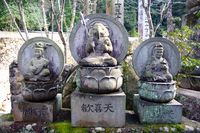
"India is culturally, Mother of Japan. For centuries it has, in her own characteristic way, been exercising her influence on the thought and culture of Japan."
- Professor Hajime Nakamura
Atsushi Taguchi[70], Gen'ichi Yamaguchi[71]Dr. Yoshihiro Kaburagi[72] have also written about the historical influence of Hinduism/India on Japan. Due to the cultural exchange between India and Japan, mainstream Hindu gods were adopted by Japanese. Ganesh is known as Kangi-ten and as Bināyaka-ten which originates from the Sanskrit name Vināyaka.
South East Asia[edit]
This whole region has been known in Hindu scriptures as Suvarṇabhumi.[73] Hinduism has been the dominant religion amongst several nations for a long time here. Indonesia[74] was dominantly Hindu until Islamization by missionaries and Islamists within the islands. At one point, lands even as far as the Philippines were part of the Chola Empire.[75]
Burma[edit]
"They did not practice Theravada Buddhism, rather they observed a form of Mahayana Buddhism much influenced by Vaishnavism and native Naga (serpent) worship."[76]
- Dr. U Than Tun
Dr. Aye Aye Mar (Indologist), Dr. Khin Maung Nyunt (archaeologist & epigraphist), U Min Naing (cultural historian), and U Aung Thwin (historian) have also written about the historical influence of Hinduism/India on Burma.
In most Hindu scriptures, Burma is known as Brahmadesh. Buddhist scriptures sometimes called it Majjhimadesh. Greek philosopher Pliny had said that on the river called Ava or Pumas or Puman, many nations along it are in general called Bracmanae or Brahmane.[77] Hence, there is also the Brahmaputra River near Burma which crosses North-East India.
Several Hindu temples here date back to pre-Buddhistic times. In Burma there is a Dagoba dedicated to Dagon (Matsya avatār of Viṣṇu) which Burmese claim is over 3000 years old.[78]
Cambodia[edit]
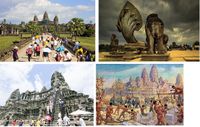
"From the 5th century, Hinduism established cults in Chenla that integrated with indigenous beliefs, creating a syncretic society... The Preah Thong myth shows how Indian origins were localized to legitimize Khmer rule."[79]
- Sovath Prak, epigraphist & historian
Chea Socheat, Michael Vickery (historian), Ros Chantrabot (historian & former diplomat), and Serey Sok (archaeologist) have also written about the historical influence of Hinduism/India on Cambodia.
The name Cambodia comes from the founder of the first Khmer Dynasty from India, who was Kambhoja. From him Cambodia is usually called by its natives as either 'Kambuja' or 'Kampuchea'. Its national flag displays the world-famous Angkor Wat Temple within the country. Angkor Wat is the largest spiritual monument in the world. It was built by King Suryavarman II.
An inscription from Anghor Vat runs thus: "The Brahman Agastya, born in the land of the Aryans, devoted to the worship of Siva, having come by his psychic powers to the land of the Cambodians for the purpose of worshipping the Siva-linga known as Bhadresvara, and having worshipped the god for a long time, attained to beatitude."
Indonesia[edit]
"Indonesia's ancient Hindu legacy, through processes of Indianization, laid the groundwork for tolerant pluralism...The Majapahit Empire (14th century) exemplifies how Hindu dharma fostered unity across ethnic groups, influencing modern Pancasila."[80]
- Professor Dr. Hilman Latief, Syarif Hidayatullah State Islamic University
Agus Aris Munandar (archaeologist and historian), I Made Titib (theologian and philosopher), Ida Bagus Putu Jandhy (philosopher and cultural scholar), and Ni Wayan Sukerti (linguist and Indologist) have also written about the historical influence of Hinduism/India on Indonesia.
The largest and most prestigious native Indonesian dynasties were Srivijaya, Mataram, Shailendra, and Majapahit. The Chola Dynasty of India was a great link between both India and Indonesia as the exchange of cultures occurred, leading to closer ties between Indonesians and Indians.
Indonesians believe that Sage Agastya and Sage Markandeya brought Hinduism to Indonesia. Hence, this shows that sages particularly of the pravara gotra lineages from Agastya and Markandeya had been the first preachers of Hinduism in the islands.
Many Indians had migrated to Indonesia, some of them being Gujaratis. It is said that King Aji Saka, who came to Java in Indonesia in year 1 of the Śaka calender, was believed to be a king of Gujarat by some.[81] It is also believed that the first Indian settlements in Java Island of Indonesia was established with the coming of Prince Dhruvavijaya of Gujarat with 5,000 traders.[81] Some stories propose that a sage named Tritresta was the first to bring Gujarati migrants with him to Java, hence some scholars equate him with Aji Saka.[82]
Laos[edit]
"Hindu influencers via Dvaravati Mon traders established elite religious practices in central Laos by the 7th century, paving the way for Theravada...This syncretic layer remains in Lao festivals symbolizing our Indosphere heritage."[83]
- Khammy Phommaseng
Bounleuam Chaleunsinh (ethnologist), Phothong Phoummachanh (historian & cultural scholar), Sisouk Vongvichit (cultural heritage expert), and Vongkot Thammavongsa (archaeologist) have also written about the historical influence of Hinduism/India on Laos.
Malaysia[edit]
"Up to the 14th century, Hindu-Buddhist influences had a major impact on Malaysian culture...The massive cultural impact of India on Malay Peninsula prior to the 14th century was virtually overwhelming, shaping early kingdoms like Langkasura and Kadaram through trade and elite adoption."[84]
- Dr. Nik Hassan Shuhaimi Nik Abdul Rahman, archaeologist and historian
Ahmad Murad Merican (literary historian), Mohd. Taib Osman (cultural anthropologist), Raja Zarina Raja Zain (social anthropologist), and Wan Suhana Wan Sulaiman (Indologist) have also written about the historical influence of Hinduism/India on Malaysia.
Thailand[edit]
"Thailand is the most crucial place for study of Sanskrit. We started to study Sanskrit long back. Hinduism and Buddhism existed in Thailand and have very strong influences."
- Professor Chirapat Prapandvidya, founder and director of Sanskrit Studies Centre at Silpakorn University in Bangkok, Thailand
Charuwan Chareonla (art historian), Kessara Srinaka (art historian), Piriya Krairiksh (art historian) and Prapod Assavavirulhakarn (Buddhist scholar) have also written about the historical influence of Hinduism/India on Thailand.
In Hindu scriptures, Burma is known as Shyamdesh. Hence the other name of the country is 'Siam'.
Vietnam[edit]
"Hinduism, introduced via Indian traders to Funan around the 1st century CE, established the socio-political framework for early Khmer-Cham societies in southern Vietnam...Temples like Óc Eo reflect this, blending Indian devaraja cults with local animism to form hybrid polities."[85]
- Tran Ky Phuong
Ngô Đức Thịnh (ethnologist & cultural historian), Phan Huy Lê (historian, former national education department president), Lương Ninh (cultural anthropologist), and Vũ Kim Thắng (epigraphist) have also written about the historical influence of Hinduism/India on Vietnam.
Oceania[edit]
"Soon after the establishment of a great Hindu civilisation in Java, and in a lessor degree in the Philippines, about the time of the Christian Era, it is certain that many expeditions of adventurous Hindu-Malay sea-captains in large ocean-going Wangkang and Barangai, "junks" and "big galleys" must have launched out into the Pacific, both by the N.W. route by way of the Moluccas, Caroline Islands and Havaii, as well as by the S.W. route, followed in much more recent times by Abel Tasman."
- F.W. Christian[86]
F.W. Christian had written of similarities between Sanskrit and Polynesian languages, such as Maori and Samoan.[87]
- Australia
Their closest blood links are with the groups in New Guinea, South India and Sri Lanka, representing their path of migration into Australia.[88]
One academic, Professor Alan Cooper, from the University of Adelaide’s Centre for Ancient DNA, says the Indian influence may well have played a role in the development of the Aboriginal culture – outlined in a paper titled ‘Genome-wide data substantiate Holocene gene flow from India to Australia’.
Professor Cooper says it is impossible to ignore the link with the discovery of the dingo…"The timing of all those things in the archaeological record, about 4,000 to 5,000 years ago, happens to match the timing estimated for this genetic influx from India."
Professor Cooper also points to another development that happened around the time of the Australia-Indian connection – an expansion of one of the Aboriginal language groups. "This other language seems to have taken over Australia relatively recently – perhaps 5,000 years ago,…And how it did it, how it replaced the other ancient languages, we don’t know…So suddenly, 4,000 to 5,000 years ago is starting to become a fairly tumultuous time in Australian history."
- New Zealand
The oldest Indian settlement in New Zealand comes from the Dānavas that sailed originally from Patala in Sind. These Indians became known locally in New Zealand as the Tuhoe.
About 150 years ago, a bell was discovered in New Zealand near Whangarei in the Northland Region with Tamil writings on it.[89] It is believed to have come from a Pallava Dynasty ship which was sailing in the area and had possibly landed on New Zealand. The bell had led Indologist, V. R. Ramachandra Dikshitar to investigate and claims in his book The Origin and Spread of the Tamils that ancient Tamil sea-farers might have had a knowledge of Australia and Polynesia. There has also been Sanskrit writing discovered on a boulder in Hokianga Harbor. This finding has led to the belief that Hindu monks had arrived in New Zealand before Europeans did.
It is even believed by some historians that among the ancestry of indigenous New Zealanders there is some Indian descent. Joan Leaf through oral tradition of genealogy (whakapapa) among the Maori and having consulted with the Maori Wharewananga, traced the lineage of her husband, who is Maori on both sides of his ancestry, back to India.[90] That the Tuhoe of New Zealand were Dānavas is further evidenced by their oral traditions which recants Dānavas having fought other Indians in the typical wars that Indian epics mention about them.
"Maori tradition tells us that their ancestors in times long past away, 165 generations ago, they migrated from a hot country named India."
- Eldson Best[91]
- Rest of Polynesia

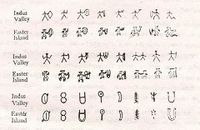
Balaram Chakravarti writes, "The Lapita potteries which seem to be of Dānava origin seems to lend evidence to the stepping stone of Dānava migration from New-Britain to Fiji with an off-shoot in New-Caledonia."[92]
Easter Island has stories among its natives of long-eared (Hanau epe) people having come there, led by Hotu Matu'a (Great Parent, a title given to their 'ariki' or king.) The Hanau epe were said to have been from Hiva (Far away land.) The reason for their migration was a great flood. The Indus Valley Civilization was devastated and abandoned due to severe flooding. Together they had built the Moai monuments.
Elongated earlobes are a common feature in many depictions of devas, gandharvas, ṛṣis and others. Long and hanging earlobes are known as larhba-karṇa. Even the Viṣṇu-koṣa[93] mentions it as a feature of Viṣṇu. Dr. B. A. Saletore had published in his book, The Wild Tribes in Indian History[94] about a tribe called the Labhakarṇas. It is not an unknown trait in Indian history and so it is likely that the Dānavas who arrived in Easter Island had elongated ears.
"It has been suggested Easter Island rongorongo script arrived from Peru, South America and is related to the Indus River Valley dating back to 2000 BC which is likely since there were Indus River Valley migrations to Peru, South America, by 1500 BC or perhaps as early as 2000 BC. Many Harappan glyphs appear in both Peruvian and Easter Island scripts."
- Jeffrey L. Gross [95]
Europe[edit]
See also: Hindu Temples in Europe
At the time that the Indo-Iranians came into Europe, the natives of Europe were Palesgians in the Balkan Peninsula, Basques in Iberian Peninsula, Fins and Sami in Northern Europe and the Magyars to later become Hungarians, Estonians and Kami in Eastern Europe and several other non-Indo-European linguistic families within the Caucasus. With the influence on the Indo-Iranian comers, the Indo-European nations of Europe were born. Some identified groups that had come into Europe were Druyus (becoming the British Druids and German Druvis), Parthians (Thracians from Parthenope and some Irish from Partholonians) and Medians.
The reason why it was easy for the Indo-European languages to gain popularity among Europe's natives is because the native Europeans were nomads that relied on hunting and gathering, the Indo-Iranians were agarians that brought an agricultural revolution. DNA samples of the Yamnayas (mixed of Indo-Iranians and Europeans) show that they were not lactose intolerant whereas the European natives were. Thus, Indo-Iranians showed Europeans to be able to live sedentary lives opposite to foraging and constantly relocating.
The Sanskrit word Deva took on vernacular forms amongst European nations wherein it became Theo in Greek, Dio in Latin and Italian, Dios in Spanish, Deos in Portuguese, Déu in Catalan, Dieu in French, Dievs in Latvian, Dievas in Lithuanian, Duw in Welsh, and the words Deity and Divinity in English. Even the word 'devil' means slanderer ('il') of god ('dev') and its Latin version is 'deofel' wherein 'deo' means god and 'fel' means slanderer. So Theology means the study of "The study of Theo" and Theism is "The belief in Theo". Further, the Sanskrit word 'Asura' became Æsir for Scandinavia's worshipers of the Norse gods.
Thrace[edit]
The Thracians called their country 'Aria'[96] which means Noble. It is a word which has much significance in Hinduism, including Buddhism and Jainism. In Hellenist mythology, Thrace was the offspring of Parthenope, the daughter of Olympian god Ares. The 'Parth' in the name Parthenope indicates Parthian and hence an Indo-Iranian origin. Goddess Hecate was portrayed as a multi-headed and multi-handed deity.
There were several tribes among Thracians. Originally there was one but as they expanded control of other territories in the Balkans, other nations became Thracianized. Hesychius notes that the Sindi tribe of Thracians was from India.[97] Sir W. Drummond was also of the same viewpoint. George Faber wrote that Thracians came from a frontier of India.[98]
The Thracians inhabited this region even before the earliest Greeks[99] made their way south to the present Greece.[100] Thracians even preceded Greeks to important islands in the northern, central, eastern and eastern Aegean. This includes Thasos, Samothrace, Imbros, Lemnos, Euboea, Naxos, Lesbos and Chios.[101]
The Sindi Colchi country, located in the Taman Peninsula, was known as Sindike and Sindikos, and its largest city was named Sinda. Greek writer Strabo referred to these Sindi as 'Sindoi'. Ancient Greek Pliny called it 'Scythia Sindica', Ptolemy as 'Indo-Scythia', and both Socrates and Stephanus as 'India'. Because the Thracians were also in the Aegean Sea, they were in Lemnos island. There was an ethnicity here named 'Sindians', whom Homer in his Iliad and Odyssey wrote, "spoke a strange language" and the Scholiast Thucydides wrote the Thracians are derived from India.[102]
"We can firmly say that the Bulgarians had entered their present areas from Hindistan (India) in the most ancient times...and their migration took place much earlier than the division of the Aryan tribe in Hindistan."
- Paisii Hilendarski[103]
Francis Wilford claimed “that so early as B.C. 189, or before it, Hindus of both sexes were not uncommon in Greece: that they were settled in Colchis, and that the Sindi of Thrace came originally from India.”
Greece[edit]
- Early Indo-Europeans in Greece
“The whole of this state of society, civil and military, must strike anyone as eminently Asiatic; much of it specifically Indian. Such it undoubtedly is. . . these evidences were but the attendant tokens of an Indian colonization with its corresponding religion and language. . . the whole of Greece, from the era of the supposed godships of Poseidon and Zeus, down to the close of the Trojan war was Indian in language, sentiment and religion, as well as the arts of peace and war.”
- Edward G Pococke
The natives of Greece were Palesgians. From the academic influence of the Indo-Iranians in the region, the ancient Greek and Latin languages were established from which all the other Indo-European languages of Europe were created. This can be seen in the wars between the Olympian gods and the Titans. Scholar Ignatius Donnelly believes the conflict between the Olympians and Titans represented a war between the Olympians and Titans.[104] Lewis Spence also mentions that the conflict between the Olympians and the Titans was of Aryans with non-Aryans with the Titans being projected as the latter.[105]
- Philosophical contribution to Greece
"We find that it (India) was visited for the purpose of acquiring knowledge by Pythagoras, Anaxarches, Pyrrho and others who afterwards became eminent philosophers in Greece."
- Dr. William Enfield[106]
Overtime, a link was established between Greece and India, wherein Greek scholars would visit India and learn from Hindu clergy. Count Bjornstjerna says that Greek philosophy was indebted almost wholly to the Hindu philosophy for its cardinal doctrines.[107] From this cultural phenomena, Pythagorus founded Pythagorism, Orpheus founded Orphism and Plato founded Platoism. Orphism from 6th century BCE believed in reincarnation[108], a Supreme God.[109] Pythagorism from 5th century BCE believed in reincarnation[110], a Supreme God[111], promoted asceticism[112] and vegetarianism.[113] Platonism from 5th century BCE believed in reincarnation[114] and a Supreme God.[115] Although Orphism, Pythagorism, and Platoism spirituality are all Hindu, Western scholars note that non-Hindu spiritualties of Greek thought also demonstrate Hindu influence such as Stoicism[116] which advocated asceticism. These schools were in start opposition to the Cyrenaicism (Greek Hedonistic school), and was opposed to Stoicism in its metaphysics.
"The Hindus were, in this respect, the teachers and not the learners."
- Henry Colebrooke [117]
When Greek scholars had spoken of philosophies of wisdom, they regarded amongst the highest as Orphism, Pythagoreanism and Platonism. Early Christian sects not only regarded Pythagorus as a prophet of God, but drew on Orphic, Pythagorean and Platonic, as well as Neo-Platonic Mystery schools.[118] Plaethon not only stated that he preferred Indian Brahmans and Magi amongst the non-Greeks, but that "inspired men" like Pythagorus, Plato and other philosophers belonging to their school, notably Parmenides, Timaeus, Plutarch, Plotinus, Porphyry and Iamblichus were great people.[119]
The Grecianized version of 'Brahman' is Brachman and Bragmanni. The ancient Greeks mention them in many instances when discussing spirituality, philosophy, astrology, geopolitics and other steams of study. In about 270-303 CE, makes distinguishing statements among the gymnosophists wherein he describes differences amongst them.[120] Purchas had written that all the things observed by Nsturall Philosophers in Greece had been handled before, partly by the Brachmancs amongst the Indians.[121] A type of non combustible cloth made from stone was also said to have been used by the Brachmancs.[122] It later became used by some in Europe.
There were also Hindu monks that had visited Greece for the purpose of discussing philosophy. Zarmanochegas is the most known of these. In Greece, he had self-immolated himself to protest Alexander's invasion of India. His tomb in Greece reads, "Here lies Zarmanochegas an Indian, a native of Bargose, having immortalized himself according to the custom of his country."[6] Other Hindu sages that were in the company of Emperor Elagabalus also were written about.[123]
- Worship of similar deities between Hindus and Hellenists
"While Dionysus (Siva) is worshipped in the mountain, Heracles (Krsna) is worshipped on the plain, especially by the Surasenoi (Surasena), an Indian people who possess two towns, Methora (Mathura) and Kleisobora (Krsnapura)"
- Megastheses[124], Greek historian and ethnographer, 4th century BCE
The gods worshiped by Hellenists were similar to that of Hindus. Whereas Indra is called Vetethragna in the Avesta, and Vahagn by the Armenians, he's also known as Artagnes-Herakles in Commagene.[125] Many of the soldiers in Alexander of Macedonia's army readily became Hindu. "Close to 10,000 Greeks, who came in the wake of Alexander the Great, were Krishna's devotees. There is an inscription by Heliodorus, the Greek ambassador at Takshila , which reads Deva, deva, Vasudeva. Krishna is my god and I have installed this Garuda Pillar at Bes Nagar (now in Bihar)," says researcher T K V Rajan.[7] Further, Hydaspes is written by Nonnus in his Dionysiaca as a son of the sea-god Thaumas and cloud-goddess Elektra. He was the brother of Iris the rainbow-goddess and half-brother of Harpies.[8]
- Other contribution of customs
"Cremation was brought by barbarians from the East [India] to the Mediterranean basin about 2500–2000 BC, where previously the practice was unknown."
- William Howels[126]
Astrology was also a science that Hindus spread with them in Greece. Philostratus tells how Iarbas the Brachman or Brahman gave Apolloneus of Tyans a set of rings for days of the week to maintain good health.[127]
Apart from the Greeks having visited India for learning Hinduism and its ideals and customs, Indians had colonized Greece as the first Indo-Iranians in the country. They were the Danauna (also known as Aavaoi), who descend from King Danaus. This king has founded the city Argos, and from his descend figures like the Danai, who are Argives mentioned by Homer.[128] They were also known as Achaians, who are mentioned separately from the people of Greece, the Hellenes, themselves because they were a foreign nationality.
Austria, Germany & Netherlands[edit]
"The runes were brought to the Germans by the Brahmins of ancient India...The priestly caste of the Teutons was identical with the Brahmin caste."
- Guido von List[129]
Guido von List the Austrian wrote that the Germanic peoples were taught by Brahmans from India. He said the German priesthood descended from Indian Brahmans.[130][131]
France[edit]
Fabre d'Olivet the Frenchman wrote that Gauls (Celtic peoples) were originally a colony of Brahmans from India.
"The Gauls were a colony of Brahmins."
- Fabre d'Olivet[132]
François-Marie Arouet wrote the the Gauls and their Druids were taught by Indian Brahmans.
"The Gauls had their Druids, who were Brahmins come from India."
- François-Marie Arouet[133]
British Isles[edit]
"I fear we must class the descent of the Afghans from the Jews with that of the Romans, and the British from the Trojans, and that of the Irish from the Milesians or Brahmins."
- Mountstuart Elphinstone[134]
Many Irish have written of an Indian influence on ancient Ireland including Mrs. Dorothy Chaplin and Madam Wilde.[135] The Druids were the chief priests of the isles and their religion is known as Druidism. Godfrey Higgins wrote a book supporting that the Druids had come from India, titled The Celtic Druids, Or, An Attempt to Shew that the Druids Were the Priests of Oriental Colonies who Emigrated from India, and Were the Introducers of the First Or Cadmean System of Letters, and the Builders of Stonehenge, of Carnac, and of Other Cyclopean Works in Asia and Europe. They were a priestly hereditary group and are said to have been descended of the Brahman Druyus. The Druids had propitiated Danu because Druyu, their patriarch, was her great-great grandson as the son of King Yayati and Queen Sarmishṭha, who was a Danava (descendant of Danu.)
Being of Indian descent, Druids would have been Indo-European speakers and they likely would have been the first speakers of the language family in the British Isles. They had also worshiped the Thracian Hecate. One group of Indo-Iranians, according to Irish legends that emigrated were the Partholonians from Parthia.[136] Druids were Partholonians because according to a legend, a person named Parthalon landed in Ireland three-hundred years after a mythic deluge and had brought with him three Druids named Fios, Folus and Fochmare.[137] They had come to Ireland from Midgonia.[138]
"The very name Druid is composed of two Celtic word roots which have parallels in Sanskrit. Indeed, the root vid for knowledge also emerges in the Sanskrit word Veda, demonstrates the similarity. The Celtic root dru which means 'immersion' also appears in the Sanskrit. So a Druid was the one 'immersed in knowledge.'"
- Peter Beresford-Ellis[139]
In history, the Druids were later pushed into Ireland and Scotland. "In Britain, the Kelts pushed the Albans into northern Ireland and northern Scotland.”[140] Druidism still survives today in the isles and revivalist efforts have been put forth by its followers.
"The island [Britain] has long been pre-disposed of it's [[[Christianity]]] through the doctrines of the Druids and Buddhists who already inculcated the doctrine of the Godhead."
- Christian cleric Origen, 3rd century CE
It is notable that there is a Druid named Arias, which even further strengthens the relationship between the Druids and Brahmans as Aria/Arya meant noble and was used in the ethical and spiritual sense even by the Buddha who referred to his creed as the Arya Astanga Dharma (Noble Eight-fold Religion.) Peter Berresford Ellis writes, "Moreover, we learn that in these four cities were 'four Druids who taught the Children of Danu skill and knowledge and perfect wisdom'. Morias dwelt in Falias; Urias 'of the noble nature' lived in Gorias; Arias the poet resided in Finias and Senias had his abode in Murias."[141]
The Druids were especially the priests of the Tuatha De Danann. D'Arbois translates Tuatha De Danann as "people of the god whose mother is called Danu." Goddess Danu written of in Celtic spirituality is the same Danu from the Ṛgveda. The Danavas, upon leaving India, moved westwards to Iran (i.e., Parthia), then more westwards, which led them to arrive in Egypt. In Egypt, these Danavas are recorded in legend to have been banished from the country where in legend, King Ramses exiled his brother Danaus. From the exile, Danaus moved to Middle Greece and eventually to Ireland. George A. Christopoulos had also connected the Danaans and Danawois to the Danawos mentioned in the Avesta.
Englishmen Francis Wilford[142], Thomas Maurice[143], and William Stukeley[144] wrote of Brahmans in the Isles. Wilford said Brahmans colonized the isles and that Druids taught Vedic doctrines, Maurice that the Druids were Brahmans, and Stukeley that the Druids were Brahmans from the East.
Irishmen Charles Vallancey[145] and John Toland[146] wrote of the Hindu connection too. Vallancey that the Irish Druids and their language were of Brahmans and Toland that the Irish Druids were Indian philosophers.
[edit]
The Norse gods referred to god as 'Æsir'. The name of thunder-god Thor comes from 'Thortian' of the Zoroastrian Vendiad and the name derives it's form from the Vedic Trita, who was known as Trita in the Avesta and then later as Traitana, then 'Thraetaona' and finally as 'Thortian' to the Zoroastrians. In Sweden's Helgö, a small Buddha statuette from North India dating from 6th century AD; was found in Viking's grave.[148]
Eastern Europe[edit]
The names of deities of Eastern Europe indicate a strong Hindu influence.
- Azerbaijan
Currently the Fire Temple of Baku is a site revered for its historic uniqueness which was established by Hindu priests from India in the 19th century. It was nominated by the Azerbaijani government for being recognized as a UNESCO Hindu Site. Currently there is an ISKCON temple in Baku[9], the country's capital city.
- Poland
Śivā is the name of a female deity in Poland, just as Śivā is the name of Kali Mātā of Hinduism, the wife of Śiva. Further, in Poland, "Vogt in his lectures of Man assumes the Polish to be descended from Hindu sources..."[149]
- Lithuania
| Deity | Vedic equivalent | About god |
|---|---|---|
| Praamžius Dievas | Prajapati | The supreme or leader of the gods. |
| Dievas Senelis ("Good Old Man") | Yama | He is a teacher of people and judge of their morality. He looks like an old traveling beggar. Dievas Senelis is proficient at magic and medicine. Epithet of Dievas. |
| Perkūnas | Prajanya | Thunder, a son of Dievas ("dievaitis.") |
| Saulė | Surya | The Sun Goddess. |
| Ašvieniai | Ashvins | The divine twins who pulled the chariot of the Sun. |
There is a Lithuanian folk song reminiscent of a Vedic tale.[150][10]
- Russia
"I also feel the great sympathy with modern Hinduism of Rama Krishna and Girikananda..."[151]
"The mystico-religious elements in Indian culture didn't interest me much...The moral teachings of early Buddhism, the personality of the Buddha, the great ascetic life of Mahatma Gandhi, who blended ancient philosophies so harmoniously with modern conditions, fascinated me far more."[152]
- Svetlana Alliluyeva, ex-atheist daughter of Joseph Stalin
In Russia's Volga region during excavation, a 7th century AD Varāha statue was found in Staraya Maina village within the Ulyanovsk region.[153] This ancient area was highly populated city 1,700 years ago. Ulyanovsk State University's archaeology department Dr. Alexander Kozhevin's team had made the discovery after having excavated the area. A famous Russian historian had written that thousands of years before the 'Kiev-Rus' culture, from which Russian nation originated, there was a 'Vedic-Rus' which was characterized by an international Vedic culture.[154] During the 14th century CE Indian gold coins were found in the Volga region near the village of Tenishevo indicating a flourishing trade between India and Russia.
Americas[edit]
Before reaching Polynesia, the Davanas passed through South America. Surprisingly, it seems they may have left a mark on the indigenous there because, like in Easter Island, the native language Aymara resembles an Indian language. In this case it is Sanskrit, which is bares similarities to the Aymara tongue spoken in Bolivian Andes mountain. Writers, such as the 19th century Vicente de Ballivián y Roxas, 20th century F.W. Christian[155], and 21st century Geoffrey V. Davis, as well as others have written about this.
- USA
“I didn't have a dorm room, so I slept on the floor in friends' rooms. I returned coke bottles for the 5¢ deposits to buy food with. And I would walk the 7 miles across town every Sunday night to get one good meal a week at the Hare Krishna temple. I loved it.”
- Steve Jobs, Stanford University conference in 2005[156]
The USA has been the base for establishing several Hindu-oriented organizations, such as ISKCON.
- Guyanas
Guyana, former British Guyana and Suriname, former Dutch Guyana, were the countries of many Hindu immigrants. Both have had Hindu leaders as heads of the government.
Africa[edit]
Technically Egypt was the first part of Africa in which the Hinduism spread.
- South Africa
The first Hindu temple in South Africa was constructed in 1869.
- Ghana

See also[edit]
- UNESCO Hindu World Heritage Sites
- Hindu Temples in Europe
- Temples
- Pilgrimages
- Zoroastrianism and Hinduism
- Historical racial diversity of Hindus
- Indus Valley Civilization
- Hindu response to conversions
- Hindu-inspired organizations
- The Hindu Renaissances
- Buddhist patronage by Hindu kings
- Sufism with Vaishnavism
- History of ancient geography
External resources[edit]
- Pacific Waves
- Seafarers
- “Western Alphabet Modelled after an Indian Alphabet 3400 Plus Years Ago – Indologist Wim Borsboom”
- "GET YOUR FACTS REICH Sorry Nazis, the swastika is 11,000 years old and INDIAN" By Jasper Hamill, 8th July 2016, 11:14 am
References[edit]
- ↑ It means Kumarayāna.
- ↑ It means Dhitika.
- ↑ It means Śakya Pandita.
- ↑ It means Tatatungya.
- ↑ It means Padmasambhava.
- ↑ It means Bodhidharma.
- ↑ P. 15 Indian Ocean In Antiquity By Julian Reade
- ↑ "Ancient cattle DNA reveals a bullish tale" By Lara Reid, Published online 12 July 2019
- ↑ P. 21-22 A Comparative Study of Religions By Y. Masih
- ↑ P. 330 The Serpent The Eagle The Lion & The Disk By Brannon Parke
- ↑ P. 370 Studies in Indian Coins By D.C. Sircar
- ↑ P. 21-22 A Comparative Study of Religions By Y. Masih
- ↑ They were called 'Turiya' in the Avesta.
- ↑ P. 25 An Inquiry Into the Ethnography of Afghanistan: Prepared and Presented to ... By Henry Walter Bellew
- ↑ It is in northern Afghanistan.
- ↑ P. 62 Mute Dreams, Blind Owls, and Dispersed Knowledges: Persian Poesis in the Transnational Circuitry By Michael M. J. Fischer
- ↑ P. 133 The works of Sir William Jones: with the life of the author by Lord Teignmouth in Thirteen Volumes Volume 3 By Sir William Jones
- ↑ Yazatas means venerable ones.
- ↑ Textual Sources for the Study of Zoroastrianism edited by Mary Boyce
- ↑ It is particularly members of the Parsi Theosophy.
- ↑ P. 264 The Parsis of India: Preservation of Identity in Bombay City By Jesse S. Palsetia
- ↑ P. 178 Parsis in India and the Diaspora edited by John Hinnells, Alan Williams
- ↑ P. 522 The British Critic: A New Review, Volume 20
- ↑ P. 49 Revelation of the Holy Grail By Chevalier Emerys
- ↑ P. 41 Gnostic Ethics and Mandaean Origins By Edwin M. Yamauchi
- ↑ P. 1xi The Zend-Avesta: The Sîrôzahs, Yasts, and Nyâyis edited by James Darmesteter, Lawrence Heyworth Mills
- ↑ It is the original name of India.
- ↑ P. 128 Handbuch der Orientalistik. Abt. 1, Der Nahe und der Mittlere Osten, Bd 8, Religion, Abschnitt 1, Religionsgeschichte des Alten Orients, Lief. 2. H. 2, A history of Zoroastrianism, Vol. 3, Zoroastrianism under Macedonian and Roman rule By Mary Boyce; Frantz Grenet
- ↑ P. viii A History of Indian Civilization: Ancient and classical traditions By Radhakamal Mukerjee, Gurmukh Ram Madan, Viśvaprakāśa Gupta
- ↑ P. 10 The Sound System of Modern Assyrian (Neo-Aramaic) By Edward Y. Odisho
- ↑ P. 421 Gazetteer of the Bombay Presidency: Tha'na (2 pts.) Volume XIII, Part II By Government Central Press
- ↑ Frahavars means angels.
- ↑ For them some scholars believe that they origin from the proto-Indo-Iranian form Asura Mazdas.
- ↑ History of Civilizations of Central Asia: The development of sedentary and nomadic civilizations: 700 B.C. to A.D. 250 By Ahmad Hasan Dani
- ↑ P. 253 The Wiley-Blackwell Companion to Zoroastrianism By Michael Stausberg, Yuhan Sohrab-Dinshaw Vevaina, Anna Tessmann
- ↑ P. 37 Persian Architectural Heritage: Architecture, Structure and Conservation By Mehrdad Hejazi, Fatemeh Mehdizadeh Saradj
- ↑ P. 253 The Wiley-Blackwell Companion to Zoroastrianism By Michael Stausberg, Yuhan Sohrab-Dinshaw Vevaina, Anna Tessmann
- ↑ Studia Orientalia, Volume 64
- ↑ P. 64 The Hebrew Pharaohs of Egypt: The Secret Lineage of the Patriarch Joseph By Ahmed Osman
- ↑ Mayrhofer II 780
- ↑ Mayrhofer II 182
- ↑ Mayrhofer II 189, II378
- ↑ Mayrhofer I 553
- ↑ Mayrhofer I 134
- ↑ Mayrhofer II 540, 696
- ↑ It is a name in Palestine.
- ↑ Mayrhofer II 209, 735
- ↑ Mayrhofer I 686, I 736
- ↑ P. 85 Arshile Gorky Adoian By Karlen Mooradian
- ↑ P. 104 Astrological Magazine, Volume 73, Issues 1-6 1984
- ↑ P. 15 Cyrus the Great - Celestial Sovereign By Sam Kerr
- ↑ P. 28 The Kingdom of Armenia: A History By M. Chahin
- ↑ P. 28 The Kingdom of Armenia: A History By M. Chahin
- ↑ p. 121 Anacalypsis: An Attempt to Draw Aside the Veil of the Saitic Isis (Vol. I) By Godfrey Higgins
- ↑ He is a foreigner "from North Syria".
- ↑ He is the male form.
- ↑ She is the female form.
- ↑ P. 218 Sea Peoples of the Bronze Age Mediterranean c.1400 BCÂ?1000 BC By Raffaele DÂ?Amato, Andrea Salimbeti
- ↑ ANCIENT ANIMAL BURIALS IN EGYPT WERE MONKEYS IMPORTED AS PETS FROM INDIA (August 25, 2020) By HeritageDaily
- ↑ It means the Land of Horses.
- ↑ P. 705 World Vedic heritage: a history of histories : presenting a unique unified field theory of history that from the beginning of time the world practiced Vedic culture and spoke Sanskrit, Volume 1 By Puruṣottam Nagesh Oak
- ↑ P. 181 Green Leaves: Harish S. Booch Memorial Volume By Harish S. Booch
- ↑ The bsTan rTsis
- ↑ P. 339 The Golden Letters: The Three Statements of Garab Dorje, First Dzogchen Master By John Myrdhin Reynolds
- ↑ They are the ones who also follow Buddhism.
- ↑ They are strictly Bonpas.
- ↑ P. 304 Annapurna: A Trekker's Guide By Siân Pritchard-Jones, Bob Gibbons
- ↑ P. 132 The Nativist Prophets of Early Islamic Iran: Rural Revolt and Local Zoroastrianism By Patricia Crone
- ↑ P. 248 Some Missing Chapters of World History By Purushottam Nagesh Oak
- ↑ "The transmission of Indian concepts—Hindu deities adapted into Shinto kami and Buddhist mandalas—exerted significant influence on Japan's religious worldview, contributing to its unique civilizational blend."
- Atsushi Taguchi, Indologist and cultural historian;
India-Japan Cultural Relations: From Ancient Times to Modern (2018) - ↑ "Indian Buddhist thought, carrying Hindu philosophical undercurrents, profoundly shaped Japanese aesthetics and social harmony, influencing everything from tea ceremonies to imperial rituals—without which modern Japanese civilization would lack its syncretic depth."
- Gen'ichi Yamaguchi, Buddhist studies scholar;
"The Influence of Indian Buddhism on Japanese Culture" (2012) article–excerpts in Journal of Indian Philosophy (2015) - ↑ "Since ancient times, Japan has assimilated various foreign cultures, particularly through Buddhism from India, which led to the formation of Japanese civilization."
- Dr. Yoshihiro Kaburagi, historian and comparative civilization scholar - ↑ It means The Golden Land.
- ↑ It was former Javadwipa.
- ↑ The Tamil Chola Empire
- ↑ Essays on the History and Buddhism of Burma (2005) By Dr. U Than Tun
- ↑ P. 443 Asiatick Researches, Or, Transactions of the Society Instituted ..., Volume 14
- ↑ P. 37 Shambhala By Nicholas Roerich
- ↑ Quote in Inscriptions du Cambodge (Volume on Chenla, 2012, EFEO) By George Cœdès
- ↑ "Hindu Roots of Indonesian Tolerance", Journal of Indonesian Islam (2009) By Hilman Latief
- ↑ 81.0 81.1 P. 67 An era of peace By Krishna Chandra Sagar
- ↑ P. 158 Foreign Influence on Ancient India By Krishna Chandra Sagar
- ↑ "From Brahmanism to Buddhism in Lao History", Lao Heritage Journal (2019) By Khammy Phommaseng
- ↑ Early History of Peninsular Malaysia (2002) By Dr. Nik Hassan Shuhaimi Nik Abdul Rahman
- ↑ Paper in Archaeology of Asia (2012) By Tran Ky Phuong
- ↑ P, 77-79 The Journal of the Polynesian Society: Volumes 1-22 By Polynesian Society (N.Z.)
- ↑ P, 77 The Journal of the Polynesian Society: Volumes 1-22 By Polynesian Society (N.Z.)
- ↑ P. 186 Native Peoples of the World: An Encylopedia of Groups, Cultures and Contemporary Issues By Steven L. Danver
- ↑ "Newly discovered Tamil inscriptions from the Tambaram area", Madras Christian College Magazine, v. 42, 1973 Gift Siromoney
- ↑ Hawaiiki to the Hokianga, 2000 BC
- ↑ "The cause of this exodus was a disastrous war with a dark skinned folk in which great numbers were slain."; Tuhoe: The Children of the Mist By Eldson Best
- ↑ P. ii The Children of Abo Tani in India, Fiji, and Polynesia: An Account of the Migration of the Indian Dānavas and the Nāgas, and Their Contribution to the Efflorescence of Culture in Fiji and Polynesia, Volume 1 By Balaram Chakravarti
- ↑ P. 311 Viṣṇu-koṣa By Śaligrama K Ramachandra Rao
- ↑ P. 375 Indian Culture: Journal of the Indian Research Institute, Volume 2, Issues 1-2 By I.B. Corporation
- ↑ Waipio Valley: A Polynesian Journey from Eden to Eden By Jeffrey L. Gross
- ↑ P. 277 Encyclopedia britannica; or, A dictionary of arts, sciences, and miscellaneous literature by Colin Macfarquhar; George Gleig
- ↑ P. 107 Asiatic Researches; Or, Transactions Of The Society, Instituted ..., Volume 10
- ↑ P. 293 The Origin of Pagan Idolatry: Ascertained from Historical ..., Volume 2 By George Stanley Faber
- ↑ They are Achaeans or Mycenaeans.
- ↑ P. 37 Chronicles, Volume 21 By Rockford Institute
- ↑ The Rise Of The Greeks By Michael Grant
- ↑ Iliad I.594; Odyssey VIII.294; P. 516 The History of India: As Told by Its Own Historians. The Muhammadan Period, Volume 1 By Sir Henry Miers Elliot
- ↑ vol. 4.369; P. 299 Myths and boundaries in southern-eastern Europe By Pal Kolsto
- ↑ P. 320 Atlantis: The Antediluvian World By Ignatius Donnelly
- ↑ P. 59 The Magic Arts in Celtic Britain By Lewis Spence
- ↑ P. 41 Bharātīya Vidyā, Volume 51 By Bharatiya Vidya Bhavan
- ↑ P. 974 Indian Law Quarterly Review, Volume 5 By Arora Law House
- ↑ P. xviii The Orphic Hymns By Apostolos N Athanassakis and Benjamin M Wolkow
- ↑ P. xiv: 'The Orphic Hymns' By Apostolos N Athanassakis and Benjamin M Wolkow.
- ↑ P. 2 Pythagoras and the Pythagoreans: A Brief History By Charles H. Kahn
- ↑ P. 97 Pythagoras and the Pythagoreans: A Brief History By Charles H. Kahn
- ↑ P. 9 Pythagoras and the Pythagoreans: A Brief History By Charles H. Kahn
- ↑ P. 9 Pythagoras and the Pythagoreans: A Brief History By Charles H. Kahn
- ↑ P. 377 The Middle Platonists, 80 B.C. to A.D. 220 By John M. Dillon
- ↑ P. 199 The Middle Platonists, 80 B.C. to A.D. 220 By John M. Dillon
- ↑ ,'Experiencing World History By Paul Vauthier Adams, Erick Detlef Langer, Lily Hwa, Peter N. Stearns, Merry E. Wiesner-Hanks
- ↑ P. 974 Indian Law Quarterly Review, Volume 5 By Arora Law House
- ↑ P. 77 Jesus: The Explosive Story of the 30 Lost Years and the Ancient Mystery By Tricia McCannon
- ↑ P. 39 Hermes in the Academy: Ten Years' Study of Western Esotericism at the ... edited by Wouter J. Hanegraaff, Joyce Pijnenburg
- ↑ P. 133 The Bhilsa Topes; Or, Buddhist Monuments of Central India, Etc By Sir Alexander Cunningham
- ↑ P. 2705 The Century Dictionary: An Encyclopedic Lexicon of the English Language, Volume 4 edited by William Dwight Whitney, Benjamin Eli Smith
- ↑ P. 686 The Gentleman's Magazine and Historical Review, Volume 202 By Sylvania Urban
- ↑ P. 6 Neoplatonic Saints: The Lives of Plotinus and Proclus by Their Students By Mark Edwards
- ↑ Arrian, Ind., VIII, 4; P. 393 History of Indian Buddhism: From the Origins to the Saka Era By Etienne Lamotte
- ↑ P. 132 Opuscula Atheniensia, Volumes 2-3; Volumes 7-10; Volume 12; Volumes 14-15; Volume 17; Volume 27; Volume 37 C.W.K. Gleerup., Nov 1, 1988
- ↑ P. 43 Honoring God to the Very, Very, Very End!
- ↑ Page 147 The Archaeological Journal - Volume 33 By The Royal Anthropological Institute of Great Britain and Ireland
- ↑ P. 306 The Century Cyclopedia of Names: A Pronouncing and Etymological Dictionary of Names in Geography, Biography, Mythology, History, Ethnology, Art, Archaeology, Fiction, Etc., Etc., Etc By Benjamin Eli Smith
- ↑ P. 67 Das Geheimnis der Runen (1908) By Guido von List
- ↑ "The German priesthood descends from Indian Brahmins."
- Die Religion der Ario-Germanen (1910) By Guido von List - ↑ "The Aryan Germans received their religion and social order from the Brahmins who migrated from India."- P. 112 Die Religion der Ario'-Germanen By Guido von List
- ↑ The Gauls were a colony of Indian Brahmins''."
- P. 45 La Langue Hebaique Restituee Vol. II (1815) By Fabre d'Olivet - ↑ Chapter 6 Philosophie de I'Histoire (1765) By François-Marie Arouet
- ↑ [P. 278 "Asiatic Journal and Monthly Register for British and Foreign India, China and Australasia Volume 28] 1829
- ↑ P. 33 Text Book of Indian Culture By Chaman Lal
- ↑ P. 7 The Book of Finglas By Seán Ó Broin; Other groups were Nemedians from Black Sea, Milesians are descendants of Milead (from his 3 sons Ir, Heremon, Heber, sent westward in search of Island of Destiny) from Iberia, Gailiuns, Liogarne and later arrivals to Moynalta were described as big, blond, fair-haired men of Teutonic origin, who came to Moynalta about the time of Alexander the Great.
- ↑ P. 229 Paradise Rediscovered: The Roots of Civilization, Volume 1 By Michael A. Cahill
- ↑ It is in Middle Greece.
- ↑ Druidism and the ancient Religions of India
- ↑ P. 28 Footprints of the Welsh Indians and Sailors of the Past By William L. Traxel
- ↑ P. 124 The Druids By Peter Berresford Ellis
- ↑ "Britain was colonised by Brahmins from India...the Druids preserved Brahminical learning."
- On Egypt and Other Countries Adjacent to the Nile By Francis Wilford and Asiatic Researches (1798) - ↑ "'The Druids of Britain were Brahmins...the Celtic religion is nothing but a corrupted form of the Brahminical system brought from India."
- Indian Antiquities (Vol. VI) By Thomas Maurice (1793-1800) - ↑ "The Druids...were of the same patriarchal religion as Abraham and the Brahmins of India."
- Stonehenge (1740) and Abury (1743) By William Stukeley - ↑ "The Irish Druids were Brahmins...the ancient Irish are descendants of Hindoo colonists."
- Collectanea de Rebus Hibernicus (1770-1804) By Charles Vallancey - ↑ "
- ↑ How did a Buddha statue land in Viking hands? BY SAM LITTLEFAIR| MARCH 24, 2016
- ↑ "The Helgo Treasure: A Viking Age Buddha" by Colm
- ↑ P. 386 The Races of Europe: A Sociological Study (Lowell Institute Lectures)'' By William Zebina Ripley
- ↑ P. 323 The Religion of the Ṛgveda By Hervey De Witt Griswold
- ↑ P. 40 Christianity Today, Volume 11 By Carl Ferdinand Howard Henry
- ↑ Only One Year: A Memoir By Svetlana Alliluyeva
- ↑ "Ancient Viṣṇu idol found in Russian town"
- ↑ India’s Emerging Partnerships in Eurasia: Strategies of New Regionalism By Dr. Nivedita Das Kundu
- ↑ P, 77 The Journal of the Polynesian Society Volumes 1-22 By Polynesian Society (N.Z.)
- ↑ Steve Jobs and the Krishna Connection By Venkata Bhatta dasa (Vineet Chander) for ISKCON News on Oct. 7, 2011
- ↑ Hinduism growing in Africa without Proselytizing by Desh Kapoor
- ↑ Hinduism growing in Africa without Proselytizing by Desh Kapoor


